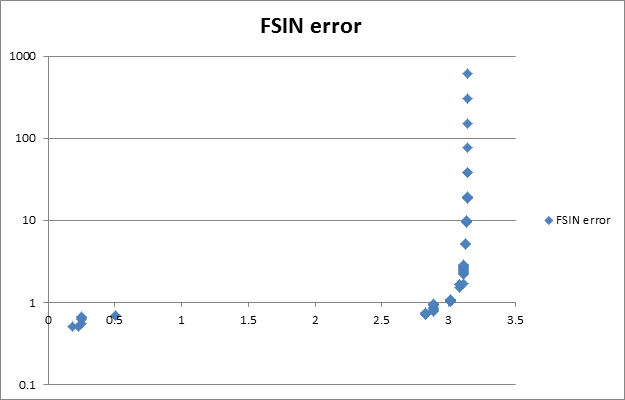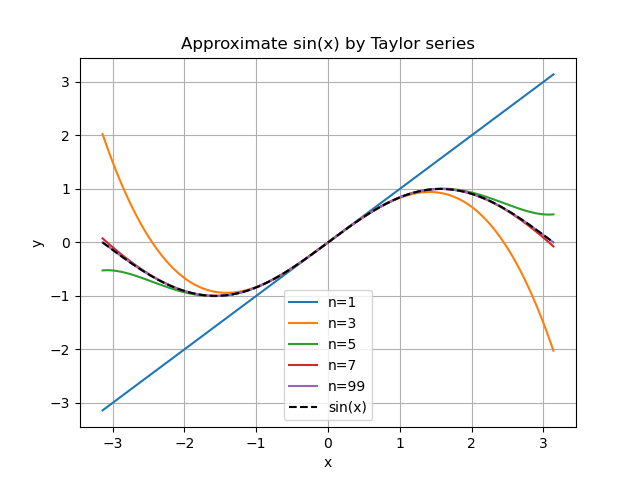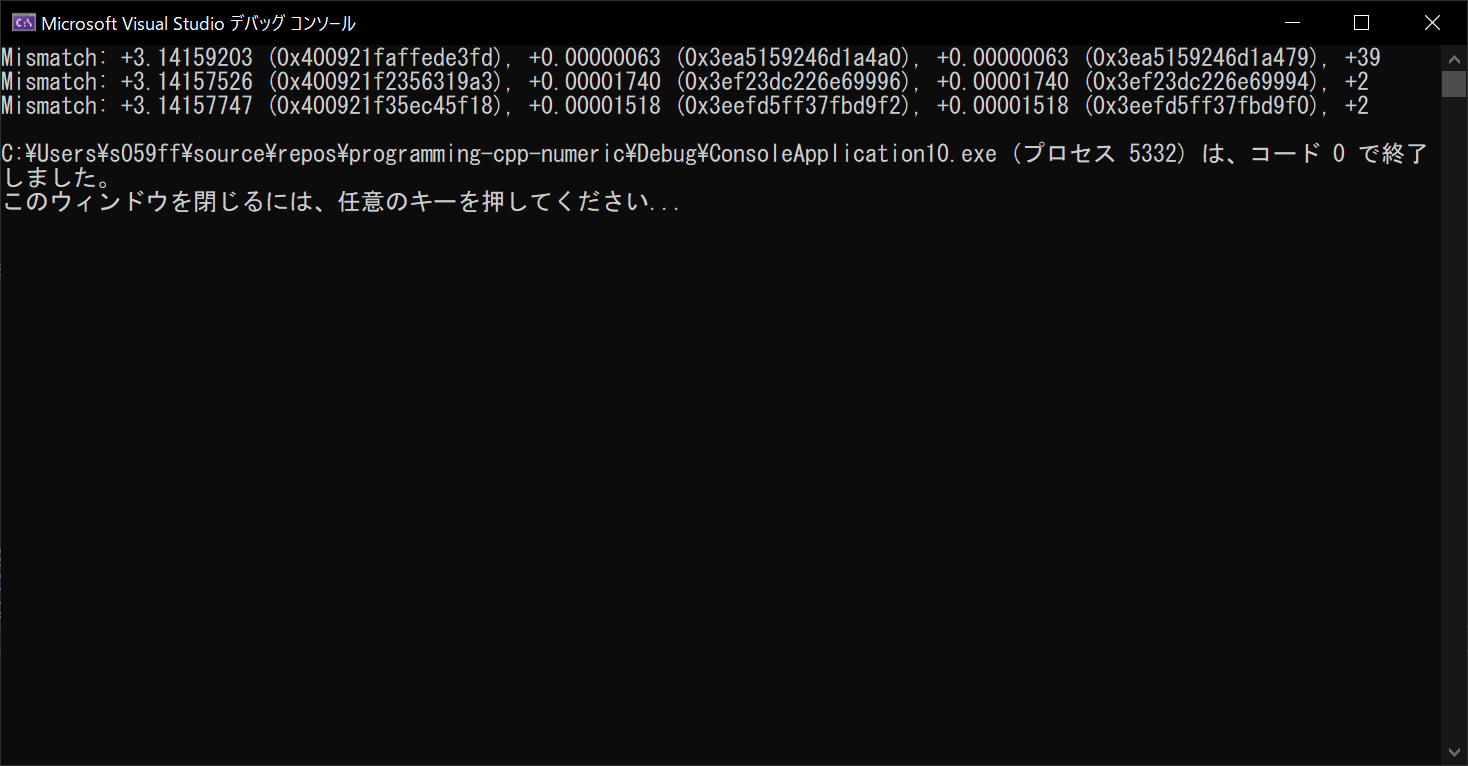コンピュータにおける三角関数の実装
※この文章は主に Intel社の文献 1 をもとに記述しています。
歴史的な話
1980年代に開発された Intel 8087 プロセッサーでは、sin cos を含む数学関数がハードウェア実装された。
現在の Intel や AMD の x86_64 アーキテクチャ CPU にも、互換性を維持する目的で実装され続けている。(x87)
しかしながら、最近のプログラミング言語で sin cos を呼び出しても、
これらの x87 命令が使用されることはなく、ソフトウェア的に計算が行われる。
それには、x87 命令の実装に使用されたアルゴリズムに、速度や精度上の欠点があるため、と言われている。
1 から引用
In the 1990s Intel replaced the 8087's CORDIC-based approximations of the elementary transcendental functions with polynomial-based approximations. These newer polynomial-based approximations provide a large degree of backwards compatibility with the CORDIC based approximations by approximating precisely the same functions, but with greater overall accuracy and speed.
具体的には、sinの場合 $x\approx\pi$ の場合に、誤差が大きくなるようである。
 1より
1より
ハードウェア実装: CORDICアルゴリズム
x87 では CORDIC アルゴリズムというアルゴリズムが使用されている。
それについては、2 の資料に詳しく説明がある。
このアルゴリズムを python で実装し、sin関数を近似すると、以下のようになった。
ソフトウェア実装: テイラー展開(マクローリン展開)
最近のプログラミング言語の三角関数の実装には、概ねテイラー展開(マクローリン展開)を用いられるようである。
テイラー展開では、求めたい関数$f(x)$を、その$n$次微分関数$f^{(n)}{(x)}$ と定数 $a$ を用いて、次式で表すことができる。
(関数 $f$ の点 $a$ まわりのテイラー級数)
$a=0$ とすると、$\sin(x)$ の微分関数は $\cos(x)$, $-\sin(x)$, $-\cos(x)$, $\sin(x)$, ... となり、
$\cos(0)= 1$, $\sin(0)=0$ であるから、偶数番目の項だけ残り、最終的に次のようになる。
$\cos(x)$ も同じように簡単な形式で表すことができる。
実際にコンピュータで計算するときは、無限個の項を計算することは不可能なので、近似的に適当な項まで計算することになる。
このアルゴリズムを python で実装し、sin関数を近似すると、以下のようになった。
付録: CORDIC アルゴリズムの実装
- CORDIC アルゴリズムで近似した sin 関数をグラフに表示するプログラムです。
- 実行には
matplotlibおよびnumpyが必要です。
import math
import matplotlib.pyplot as plt
import numpy as np
class CORDIC:
def __init__(self, n: int) -> None:
self.n = n
self.theta = [math.atan2(1, math.pow(2, i)) for i in range(n)]
w = 1.0
h = 1.0
for i in range(n):
w = math.sqrt(math.pow(w, 2) + math.pow(h, 2))
h = w * pow(0.5, i + 1)
self.r = w
def compute(self, theta: float) -> float:
t = 0.0
x = 1.0
y = 0.0
for i in range(self.n):
if t < theta:
t += self.theta[i]
s = +1.0
else:
t -= self.theta[i]
s = -1.0
x_ = x
y_ = y
x = x_ - s * math.pow(0.5, i) * y_
y = y_ + s * math.pow(0.5, i) * x_
return x, y
def approx_sin(self, theta: float) -> float:
_, y = self.compute(theta)
return y / self.r
def approx_cos(self, theta: float) -> float:
x, _ = self.compute(theta)
return x / self.r
def approx_tan(self, theta: float) -> float:
x, y = self.compute(theta)
return y / x
def main():
cordic1 = CORDIC(n=1)
cordic3 = CORDIC(n=3)
cordic5 = CORDIC(n=5)
cordic7 = CORDIC(n=7)
cordic99 = CORDIC(n=99)
x = np.linspace(-math.pi, math.pi, 1000)
y = np.vectorize(math.sin)(x)
y1 = np.vectorize(lambda x: cordic1.approx_sin(x))(x)
y3 = np.vectorize(lambda x: cordic3.approx_sin(x))(x)
y5 = np.vectorize(lambda x: cordic5.approx_sin(x))(x)
y7 = np.vectorize(lambda x: cordic7.approx_sin(x))(x)
y99 = np.vectorize(lambda x: cordic99.approx_sin(x))(x)
plt.plot(x, y1, label="n=1")
plt.plot(x, y3, label="n=3")
plt.plot(x, y5, label="n=5")
plt.plot(x, y7, label="n=7")
plt.plot(x, y99, label="n=99")
plt.plot(x, y, linestyle="dashed", color="black", label="sin(x)")
plt.title("Approximate sin(x) by CORDIC algorithm")
plt.xlabel("x")
plt.ylabel("y")
plt.legend()
plt.grid()
plt.show()
plt.close()
if __name__ == "__main__":
main()
付録: テイラー展開を使用した近似sin関数の実装
- テイラー展開で近似した sin 関数をグラフに表示するプログラムです。
- 実行には
matplotlibおよびnumpyが必要です。
import math
import matplotlib.pyplot as plt
import numpy as np
def approx_sin(x: float, n: int):
t = 0.0
for i in range(1, n + 1, 2):
s = +1.0 if (i - 1) % 4 == 0 else -1.0
t += s * pow(x, i) / math.factorial(i)
return t
def main():
x = np.linspace(-math.pi, math.pi, 1000)
y = np.vectorize(math.sin)(x)
y1 = np.vectorize(lambda x: approx_sin(x, n=1))(x)
y3 = np.vectorize(lambda x: approx_sin(x, n=3))(x)
y5 = np.vectorize(lambda x: approx_sin(x, n=5))(x)
y7 = np.vectorize(lambda x: approx_sin(x, n=7))(x)
y99 = np.vectorize(lambda x: approx_sin(x, n=99))(x)
plt.plot(x, y1, label="n=1")
plt.plot(x, y3, label="n=3")
plt.plot(x, y5, label="n=5")
plt.plot(x, y7, label="n=7")
plt.plot(x, y99, label="n=99")
plt.plot(x, y, linestyle="dashed", color="black", label="sin(x)")
plt.title("Approximate sin(x) by Taylor series")
plt.xlabel("x")
plt.ylabel("y")
plt.legend()
plt.grid()
plt.show()
plt.close()
if __name__ == "__main__":
main()
付録: x87 fsin と C++ 標準ライブラリの sin() の比較
説明
x87 fsin 命令と、C++ 標準ライブラリの sin 関数の計算結果を比較し、乖離があるか調べるプログラムです。
- 0 ~
M_PIまでの範囲から、一様分布の確率分布で、疑似乱数 x を生成します。 - C++ 標準ライブラリの
sin()で sin(x) の近似値を求めます。(y1) - x87 fsin で sin(x) の近似値を求めます。(
y2) - 2 3 の計算結果に (大きな) 違いがある場合、コンソールに
xy1y1y2差を表示します。- "差" はメモリのビットレベルでの差です。(
reinterpret_cast<const int64_t&>(y1) - reinterpret_cast<const int64_t&>(y2))
- "差" はメモリのビットレベルでの差です。(
- 1 - 4 を N(=1000000) 回繰り返します。
実行結果
- Windows 10 Pro 64bit
- AMD Ryzen 7 3700X プロセッサー (Intel CPU など他の CPU では実行結果が多少変わるかもしれません。)
ソースコード
※Visual Studio 2022 でビルド、動作。ターゲットプラットフォームを x86 にすること。(x64 ではビルドエラー)
#define _USE_MATH_DEFINES
#include <algorithm>
#include <cmath>
#include <iostream>
#include <iomanip>
#include <numeric>
#include <random>
#include <vector>
using F = double;
using I = int64_t;
static_assert(sizeof(F) == sizeof(I), "");
constexpr size_t N = 1000000;
constexpr unsigned int S = 12345;
int main()
{
std::default_random_engine engine(S);
std::uniform_real_distribution<F> dist(0, static_cast<F>(M_PI));
std::cout
<< std::fixed
<< std::setprecision(8)
<< std::showbase
<< std::showpos;
F x = 0;
F y1 = 0, y2 = 0;
const I& x_i = reinterpret_cast<const I&>(x);
const I& y1_i = reinterpret_cast<const I&>(y1);
const I& y2_i = reinterpret_cast<const I&>(y2);
for (size_t i = 0; i < N; i++)
{
x = dist(engine);
y1 = sin(x);
__asm {
fld x
fsin
fstp y2
}
auto diff = y1_i - y2_i;
if (1 < abs(diff))
{
std::cout << "Mismatch: "
<< x << " " << "(" << std::hex << x_i << ")" << ", "
<< y1 << " " << "(" << std::hex << y1_i << ")" << ", "
<< y2 << " " << "(" << std::hex << y2_i << ")" << ", "
<< std::dec << diff << std::endl;
}
}
}
1 で説明されていたように、$x\approx\pi$ の場合、正確な値から大きく乖離してしまうようです。
-
https://www.intel.com/content/dam/develop/external/us/en/documents/x87trigonometricinstructionsvsmathfunctions.pdf, "The Difference Between x87 Instructions FSIN, FCOS, FSINCOS, and FPTAN and Mathematical Functions sin, cos, sincos, and tan" ↩ ↩2 ↩3 ↩4
-
https://teamcoil.sp.u-tokai.ac.jp/calculators/column/100224/index.html, "「サルでも分かるCORDICアルゴリズム」" ↩
-
https://ja.wikipedia.org/wiki/%E3%83%86%E3%82%A4%E3%83%A9%E3%83%BC%E5%B1%95%E9%96%8B, "テイラー展開" ↩ ↩2




